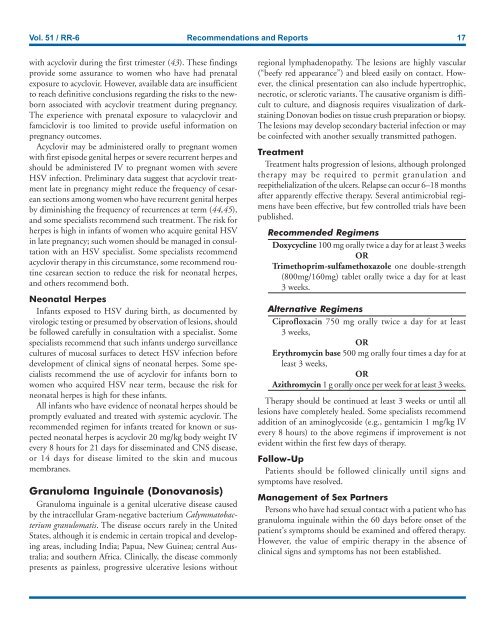You also want an ePaper? Increase the reach of your titles
YUMPU automatically turns print PDFs into web optimized ePapers that Google loves.
Vol. 51 / RR-6 Recommendations and Reports 17<br />
with acyclovir during the first trimester (43). These findings<br />
provide some assurance to women who have had prenatal<br />
exposure to acyclovir. However, available data are insufficient<br />
to reach definitive conclusions regarding the risks to the newborn<br />
associated with acyclovir treatment during pregnancy.<br />
The experience with prenatal exposure to valacyclovir and<br />
famciclovir is too limited to provide useful information on<br />
pregnancy outcomes.<br />
Acyclovir may be administered orally to pregnant women<br />
with first episode genital herpes or severe recurrent herpes and<br />
should be administered IV to pregnant women with severe<br />
HSV infection. Preliminary data suggest that acyclovir treatment<br />
late in pregnancy might reduce the frequency of cesarean<br />
sections among women who have recurrent genital herpes<br />
by diminishing the frequency of recurrences at term (44,45),<br />
and some specialists recommend such treatment. The risk for<br />
herpes is high in infants of women who acquire genital HSV<br />
in late pregnancy; such women should be managed in consultation<br />
with an HSV specialist. Some specialists recommend<br />
acyclovir therapy in this circumstance, some recommend routine<br />
cesarean section to reduce the risk for neonatal herpes,<br />
and others recommend both.<br />
Neonatal Herpes<br />
Infants exposed to HSV during birth, as documented by<br />
virologic testing or presumed by observation of lesions, should<br />
be followed carefully in consultation with a specialist. Some<br />
specialists recommend that such infants undergo surveillance<br />
cultures of mucosal surfaces to detect HSV infection before<br />
development of clinical signs of neonatal herpes. Some specialists<br />
recommend the use of acyclovir for infants born to<br />
women who acquired HSV near term, because the risk for<br />
neonatal herpes is high for these infants.<br />
All infants who have evidence of neonatal herpes should be<br />
promptly evaluated and treated with systemic acyclovir. The<br />
recommended regimen for infants treated for known or suspected<br />
neonatal herpes is acyclovir 20 mg/kg body weight IV<br />
every 8 hours for 21 days for disseminated and CNS disease,<br />
or 14 days for disease limited to the skin and mucous<br />
membranes.<br />
Granuloma Inguinale (Donovanosis)<br />
Granuloma inguinale is a genital ulcerative disease caused<br />
by the intracellular Gram-negative bacterium Calymmatobacterium<br />
granulomatis. The disease occurs rarely in the United<br />
States, although it is endemic in certain tropical and developing<br />
areas, including India; Papua, New Guinea; central Australia;<br />
and southern Africa. Clinically, the disease commo<strong>nl</strong>y<br />
presents as pai<strong>nl</strong>ess, progressive ulcerative lesions without<br />
regional lymphadenopathy. The lesions are highly vascular<br />
(“beefy red appearance”) and bleed easily on contact. However,<br />
the clinical presentation can also include hypertrophic,<br />
necrotic, or sclerotic variants. The causative organism is difficult<br />
to culture, and diagnosis requires visualization of darkstaining<br />
Donovan bodies on tissue crush preparation or biopsy.<br />
The lesions may develop secondary bacterial infection or may<br />
be coinfected with another sexually transmitted pathogen.<br />
Treatment<br />
Treatment halts progression of lesions, although prolonged<br />
therapy may be required to permit granulation and<br />
reepithelialization of the ulcers. Relapse can occur 6–18 months<br />
after apparently effective therapy. Several antimicrobial regimens<br />
have been effective, but few controlled trials have been<br />
published.<br />
Recommended Regimens<br />
Doxycycline 100 mg orally twice a day for at least 3 weeks<br />
OR<br />
Trimethoprim-sulfamethoxazole one double-strength<br />
(800mg/160mg) tablet orally twice a day for at least<br />
3 weeks.<br />
Alternative Regimens<br />
Ciprofloxacin 750 mg orally twice a day for at least<br />
3 weeks,<br />
OR<br />
Erythromycin base 500 mg orally four times a day for at<br />
least 3 weeks,<br />
OR<br />
Azithromycin 1 g orally once per week for at least 3 weeks.<br />
Therapy should be continued at least 3 weeks or until all<br />
lesions have completely healed. Some specialists recommend<br />
addition of an aminoglycoside (e.g., gentamicin 1 mg/kg IV<br />
every 8 hours) to the above regimens if improvement is not<br />
evident within the first few days of therapy.<br />
Follow-Up<br />
Patients should be followed clinically until signs and<br />
symptoms have resolved.<br />
Management of Sex Partners<br />
Persons who have had sexual contact with a patient who has<br />
granuloma inguinale within the 60 days before onset of the<br />
patient’s symptoms should be examined and offered therapy.<br />
However, the value of empiric therapy in the absence of<br />
clinical signs and symptoms has not been established.


